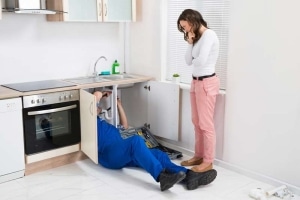Leading Tips for Fixing a Leaking Waste Disposal Unit
Leading Tips for Fixing a Leaking Waste Disposal Unit
Blog Article
We have unearthed this great article about Garbage Disposal Leaking From Bottom down the page on the web and think it made sense to discuss it with you over here.

Waste disposal unit are crucial kitchen area appliances that aid in dealing with food waste effectively. Nonetheless, a dripping waste disposal unit can be an aggravating and untidy trouble to take care of. Thankfully, numerous leakages can be dealt with conveniently with a couple of straightforward steps. In this post, we will go over just how to repair a dripping garbage disposal successfully.
Introduction
Waste disposal unit are installed under kitchen sinks and are created to shred food waste into smaller items, permitting it to pass through the pipes system conveniently. While these devices are usually reputable, leakages can take place with time due to deterioration, loose connections, or damages to the system.
Typical Causes of Leaks in Waste Disposals
Worn Seals and Gaskets
Seals and gaskets play an essential function in avoiding water from leaking out of the waste disposal unit. Gradually, these elements can deteriorate, leading to leaks around the disposal system.
Loose Links
The links in between the waste disposal unit and the plumbing system can become loosened with time, creating water to leakage out throughout procedure.
Fractures or Holes in the Disposal Unit
Physical damages to the waste disposal unit, such as cracks or holes in the housing, can additionally result in leaks.
Determining the Resource of the Leakage
Before attempting to fix a dripping waste disposal unit, it is necessary to recognize the resource of the leakage. This can commonly be done through aesthetic inspection or by carrying out simple tests.
Visual Evaluation
Examine the garbage disposal unit thoroughly for any signs of water leakage. Pay close attention to areas around seals, gaskets, and connection factors.
Examining for Leaks
One means to check for leakages is by running water with the disposal device and checking for any kind of visible signs of leak.
Devices and Materials Needed for Dealing With a Dripping Garbage Disposal
Prior to beginning the repair service process, collect the necessary tools and products, consisting of a screwdriver, flexible wrench, plumbing professional's putty, replacement seals or gaskets, and epoxy or patching material for repairing cracks or holes.
Step-by-Step Overview to Dealing With a Leaking Garbage Disposal
Switch off the Power
Before trying any kind of repair services, make sure that the power to the waste disposal unit unit is shut off to prevent the threat of electric shock.
Find the Leakage
Identify the exact place of the leak and identify the reason.
Tighten up Connections
Make use of a wrench to tighten up any type of loose links between the disposal system and the pipes system.
Change Seals or Gaskets
If the leakage results from worn seals or gaskets, get rid of the old elements and change them with brand-new ones.
Patching Fractures or Holes
For splits or openings in the disposal unit, usage epoxy or an appropriate patching product to seal the broken area.
Checking the Garbage Disposal After Repair Work
When the repair is full, test the waste disposal unit by running water via it to ensure that the leakage has actually been solved.
Preventive Maintenance Tips to Avoid Future Leaks
To avoid future leakages, it is important to execute routine maintenance on your waste disposal unit. This includes keeping it clean, preventing placing non-food products or difficult things down the disposal, and regularly checking for leakages or other concerns.
Final thought
To conclude, dealing with a dripping waste disposal unit is a fairly simple process that can be finished with fundamental devices and products. By following the actions detailed in this short article and practicing preventive maintenance, you can keep your waste disposal unit in good working condition and avoid expensive repairs in the future.
HERE’S HOW TO FIX YOUR GARBAGE DISPOSAL
WHAT TO DO IF SOMETHING IS STUCK IN YOUR GARBAGE DISPOSAL
If the impeller won’t turn, there’s probably something stuck in the disposal. It could be a steak bone or peach pit, although plumbers report pulling all sorts of inappropriate objects out of disposals, such as bottle caps or aluminum foil. Make sure power to the disposal is off, and look inside to see if you can see the source of the jam.
Never stick your fingers in a disposal. Pull out anything you see with tongs or pliers.
If the disposal still won’t work, it may be time to call a plumber or consider buying a new disposal. GEM Plumbing & Heating is here for all of your garbage disposal needs.
WHAT TO DO IF YOUR GARBAGE DISPOSAL DRAIN IS CLOGGED
Take everything out from underneath your sink and put a bucket or other container under your disposal to catch any water that drains out. Disconnect your disposal from the power supply. If it’s plugged into a wall outlet, unplug it. If it’s hardwired into an electrical box, go to the electrical panel and turn off the breaker for the disposal. Pour ¼ cup of baking soda into the drain, followed by ½ cup of white vinegar. Give the solution a few minutes to fizz and do its work. Look into the disposal with a flashlight to see if you can see an object that might be causing the clog. If you see it, remove it using tongs or pliers. MORE TIPS ON DEALING WITH A CLOGGED GARBAGE DISPOSAL
Never use drain cleaner in a garbage disposal. It can damage the plastic parts inside the disposal. You can also be splashed with the caustic liquid while working to clear the clog. Beware! Never stick your fingers into a garbage disposal. Trust us — not a good idea. In many instances, your dishwasher drains through your garbage disposal. This allows the disposal to grind any large food particles that may be drained out of your dishwasher. There are some jurisdictions, however, where the plumbing code prohibits such a connection. WHAT TO DO WHEN YOUR DISHWASHER DRAINS THROUGH THE DISPOSAL
Run some water in the sink so your plunger has at least a ½-inch of water to create a seal and plunge vigorously up and down several times. You may need to repeat this several times. Run hot water down the drain to clear any residue that remains.

We were guided to that report about Why Is from an associate on our other website. Sharing is caring. Helping people is fun. Thanks a lot for your time. Visit again soon.
Click Here Report this page